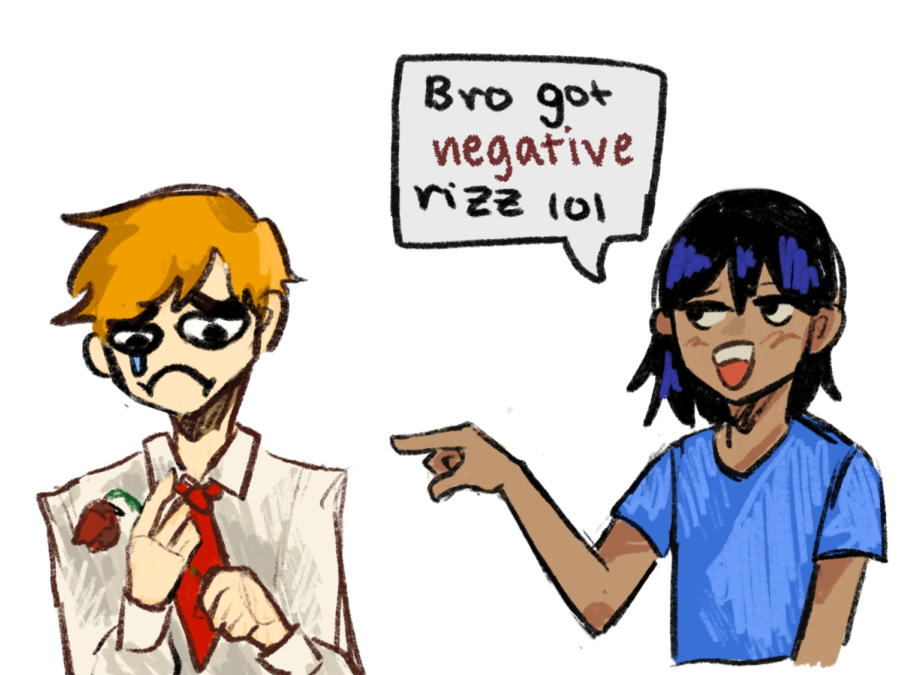‘Rizz,’ ‘mid,’ ‘W’: older generations decode Gen-Z lingo
Generation Z has developed new catchphrases that can sometimes be confusing for other generations.
May 24, 2023
Gen Z’s dialect is sometimes hard to comprehend at first glance: why is the childless Taylor Swift referred to as “mother?” Why might someone’s outfit “give washed up DCOM actor?” One can tell that such phrases aren’t part of what most consider traditional or “normal” speech. For those born between the years 1981 to 1996—millennials—the difficulty would probably be in figuring out what exactly all these new terms mean. They would probably reminisce about the days of “adulting” and “doggo” as they tried to interpret the unforgiving world of Gen Z slang. Right?
There certainly are some barriers to push through when it comes to generational language differences. New terms are created often, and even older members of the same Generation Z (those born between 1997 and 2012) might find it hard to keep up with the evolution of language. There are countless “Gen Z slang guides” to be found upon a quick Google search. Publications like the New York Times have published multiple pieces on workplace miscommunication involving Gen Z slang. The Washington Post has a quiz entitled “Cringe quiz: Are you fluent in Gen-Z office speak?”
The misunderstandings of Gen Z slang are not necessarily the fault of older generations, however. Gen Z grew up with online access—the first iPhone was released in 2007 when the oldest members of Gen Z were only ten years old and still in elementary school. There is also no question about the immense influence social media has on daily life; as communication became instant, so did the spread and evolution of language. With the rapid development of the Internet and social media sites like Instagram and Twitter (the “Bird app”, in Gen Z), any viral tweet or short video can popularize a new word or phrase almost instantaneously.
For example, take the word “cheugy.” The word is a generally negative term for a millennial, and its hashtag #cheugy has 334.7 million views on TikTok. According to Google Trends, before Apr. 2021, it received no more than one search a week, but with one viral TikTok by Hallie Cain, it blew up on social media.
Words like “cheugy” aren’t restricted to social media platforms. RM students, like many students across the globe, are well aware of common TikTok slang, and teachers at RM hear it being used more often. The trouble is, most teachers aren’t members of Generation Z. “In the halls, I hear ‘mid’ a lot, ‘rizz’ a lot, which are words that I had not heard of before a few months ago,” said science teacher Stuart Albaugh, a member of the millennial generation. “The first time I heard ‘ate’ I was like, ‘What are you saying?’,” Mr. Albaugh said. But this doesn’t mean that teachers like Mr. Albaugh have trouble communicating with students because of slang. “There aren’t really any obstacles,” Mr. Albaugh said. “I understand what they’re trying to say, to me it just sounds weird.”
In fact, all things considered, millennials and Gen Z are not very separate in terms of communication – rather, research suggests the opposite. Studies conducted by the Pew Research Center suggest that Gen Z and millennials agree on many political issues, such as their mutual concern for climate change. Additionally, Gen Z, like most millennials, want to seek alternative energy sources, are pro-large government, and strongly disapproved of former President Trump during the late stages of his presidency. According to Pew, about 35% of Gen Z and 25% of millennials are familiar with gender-neutral pronouns, while Gen X drops about ten percent to 16%, Baby Boomers 12%, and the Silent generation (born 1928 to 1945) a mere 7%. The majority of Gen Z and millennials approve of the NFL kneeling protests while Gen X, Boomers, and the Silents skew in the opposite direction. These younger generations also see increased racial and ethnic diversity as a good thing, again, in significantly larger numbers than the older ones. While each generation might use different terminology in their day-to-day lives, what they’re saying is quite similar.
The real struggles for communication usually occur in the workplace, between Gen X bosses and Gen Z employees, who are just now entering the workforce in large numbers. Purdue Global shows that most of the workforce is made up of these two generations as Boomers retire and the rest of Gen Z work their way through school. This may create some issues, especially when Gen Z employees have to communicate with their bosses in an appropriate and comprehensible way. We have yet to see how this generational gap in the workplace will manifest in the long run.
Besides, while Gen Z is definitely the most tech-savvy generation of them all, millennials are not far behind. 86% of millennials use social media daily, according to the University of Texas, and “cheugy” spreader Cain is on the cusp of being a millennial herself.
While there is a healthy gap between Gen Z and other generations, when it comes to communication with millennials, there is no meaningful difference. Both generations are able to understand each other well enough, even if millennials use more “outdated” terms while Gen Z uses more seemingly-random words and phrases. It’s also worth noting that not all millennials can use Gen Z terms naturally or effectively, though this might just highlight Gen Z’s unrealistic expectations. “They just try a little too hard,” sophomore Tarini Tippa said. As time goes on, a deeper look into the development of language structures, social media innovations, societal changes, and other key factors will be necessary to fully grasp the complex nuances of the generational language gap. In the meantime, though modern dialects will continue to evolve, millennials and Gen Z should have no problems with daily communication.


